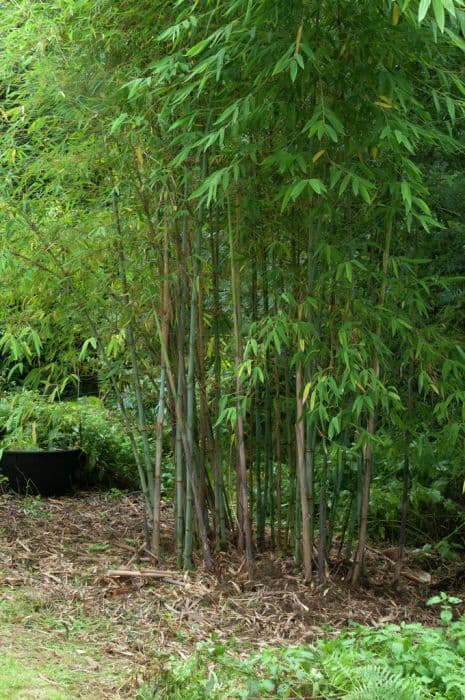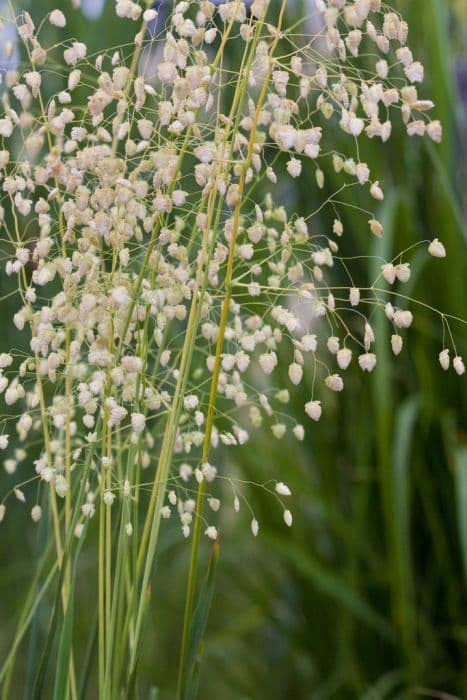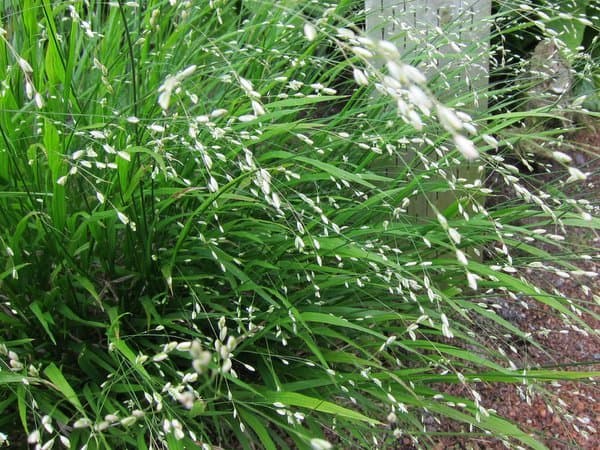Bamboo × Phyllosasa tranquillans

ABOUT
The × Phyllosasa tranquillans, also known as Tranquil Bamboo, exhibits the graceful characteristics typical of a bamboo plant. It possesses a clump-forming habit with numerous cane-like stems that grow closely together, giving it a dense and bushy appearance. These stems, or culms, are usually hollow and have a distinct segmented look with noticeable nodes separating the various sections. The culms showcase a greenish color that may vary in hue depending on the plant's age and growing conditions. The leaves of the Tranquil Bamboo are a key feature, often long and narrow, with a lanceolate shape that tapers towards the tip. They display a lush green color and can grow in alternating patterns along the branches stemming from the central culms. The leafy branches give the bamboo an overall airy and feathery look, which rustles gently with the wind. The foliage of the Tranquil Bamboo may also present a glossy finish, sometimes with a slightly textured or leathery feel, contributing to the plant's visual interest. At certain times of the year, if conditions are favorable, it might produce small, inconspicuous flowers that are seldom noticed due to their size and color blending with the foliage. Overall, the growth pattern of Tranquil Bamboo creates a serene and peaceful aesthetic, often making it a popular choice for ornamental use in gardens where its appearance can evoke a sense of calmness and tranquility. Its ability to form dense clumps also allows it to serve as an effective natural screen or hedge in landscaping.
About this plant
 Names
NamesFamily
Poaceae.
Synonyms
No common names available.
Common names
× Phyllosasa tranquillans.
 Toxicity
ToxicityTo humans
× Phyllosasa tranquillans, commonly known as a type of Fargesia, does not have a well-documented profile of toxicity to humans in general horticultural literature. There is no substantial evidence that it is harmful if ingested. However, as with any plant not widely recognized for its edibility, it is advisable to avoid ingesting parts of this plant due to possible individual allergic reactions or gastrointestinal discomfort largely undocumented due to its non-culinary usage.
To pets
× Phyllosasa tranquillans, commonly known as a type of Fargesia, is not specifically listed as toxic to pets such as cats and dogs in most toxicity databases or reference resources. While there is a general lack of detailed information on its effects if ingested by pets, it is generally recommended to prevent pets from ingesting plants not intended for animal consumption to avoid potential allergic reactions or gastrointestinal distress. If any part of the plant is ingested, monitor the pet for any signs of illness and consult a veterinarian if any concerning symptoms arise.
 Characteristics
CharacteristicsLife cycle
Perennials
Foliage type
Evergreen
Color of leaves
Green
Height
10 feet (3 meters)
Spread
6 feet (1.8 meters)
Plant type
Bamboo
Hardiness zones
7
Native area
Hybrid
Benefits
 General Benefits
General Benefits- Landscape enhancement - × Phyllosasa tranquillans, commonly known as Bamboo, can add aesthetic value to gardens and landscapes with its lush, green foliage and elegant growth habit.
- Erosion control - Bamboo has strong root systems that can help stabilize the soil and prevent erosion, especially on slopes or in areas with loose soil.
- Noise reduction - Planting bamboo can help reduce noise pollution, as their dense growth can absorb sound waves.
- Privacy screen - Due to its tall and dense nature, bamboo can provide a natural privacy screen for homes or outdoor spaces, creating a secluded atmosphere.
- Shade provider - Bamboo plants can grow to form a canopy that offers shade in sunny areas, creating a cooler microclimate beneath.
- Carbon sequestration - Like other plants, bamboo absorbs carbon dioxide and releases oxygen, thereby helping to reduce greenhouse gases in the atmosphere.
- Habitat for wildlife - Bamboo can serve as a habitat for various species of wildlife, including birds, insects, and small mammals, increasing biodiversity.
 Medical Properties
Medical PropertiesThis plant is not used for medical purposes.
 Air-purifying Qualities
Air-purifying QualitiesThis plant is not specifically known for air purifying qualities.
 Other Uses
Other Uses- Acoustic Barrier: × Phyllosasa tranquillans can be used to create natural sound barriers due to its dense foliage, effectively reducing noise pollution in suburban areas.
- Erosion Control: The extensive root system of this bamboo can help stabilize soil on slopes and prevent erosion.
- Privacy Screening: The tall and dense growth habit makes it an excellent plant for creating private green spaces in gardens and balconies.
- Crafts and Art: The canes of × Phyllosasa tranquillans can be used in crafting various items such as picture frames, mats, or decorative interior designs.
- Fodder: Although not its primary use, leaves may be used as fodder for some herbivores in farm settings.
- Windbreaks: Planted in rows, this plant can serve as a windbreak, protecting other plants and reducing wind speeds in open areas.
- Shade Provider: With its tall and broad leaves, it can provide shade for understory plants, small structures, or sitting areas.
- Culinary Decoration: Young shoots or leaves may be used as a decorative element in gourmet presentations.
- Theme Gardens: It can be essential in creating oriental or zen garden themes due to its Asian origin and aesthetic appeal.
- Biodegradable Plant Supports: Dried culms can be cut and used as natural, biodegradable stakes for supporting other plants in the garden.
Interesting Facts
 Feng Shui
Feng ShuiThe plant × Phyllosasa tranquillans, commonly referred to as the "bamboo", can be used in Feng Shui by placing it in the wealth corner of your home or office -- typically the southeast -- to attract prosperity and good fortune, or in areas where you want to introduce growth and vitality. Its upward growing nature symbolizes upward movement, such as career advancement or personal improvement.
 Zodiac Sign Compitability
Zodiac Sign CompitabilityThe bamboo is not used in astrology practice.
 Plant Symbolism
Plant Symbolism- Peace: The very name "tranquillans" suggests tranquility, so × Phyllosasa tranquillans symbolizes a sense of peace and calmness, resembling the serene experience of being surrounded by green foliage and nature.
- Resilience: Bamboo, in general, denotes strength and resilience due to its ability to bend in a storm without breaking, which can be associated with the ability to adapt in adversity.
- Flexibility: Reflecting the general characteristics of bamboo, this hybrid also symbolizes the quality of being flexible and adaptable in different conditions and situations.
- Growth: Bamboos are known for their fast growth, hence × Phyllosasa tranquillans may represent rapid growth and progress in one's personal or professional life.
- Longevity: Bamboo is often seen as a symbol of long life owing to its durability and evergreen nature, exactly what one might extrapolate for × Phyllosasa tranquillans as well.
 Water
WaterTo water the × Phyllosasa tranquillans, commonly known as the Tranquil Bamboo, you should keep the soil consistently moist but not waterlogged. Water the plant when the top inch of soil feels dry to the touch, which might be roughly once a week, but frequency will depend on environmental conditions such as temperature and humidity. Use lukewarm water and gently pour it directly onto the soil until it begins to drain from the bottom of the pot, which may require around half a gallon for a medium-sized pot every watering session. During the winter months, reduce the frequency to every other week as the plant's growth slows down.
 Light
LightThe Tranquil Bamboo thrives best in bright, indirect sunlight. It should be placed in a location where it receives natural light but is shielded from the direct intensity of the midday sun, such as near a window with a sheer curtain. A north or east-facing window would be an ideal spot for this plant to ensure it receives the optimal light without being exposed to harsh sunbeams that can scorch its leaves.
 Temperature
TemperatureThe ideal temperature range for the Tranquil Bamboo is between 60 and 75 degrees Fahrenheit. It can tolerate a minimum temperature of 55 degrees Fahrenheit and a maximum of 80 degrees Fahrenheit. Always protect the plant from drastic temperature changes and drafts, which can be harmful to its health.
 Pruning
PruningPruning the Tranquil Bamboo is generally done to maintain its shape and remove any dead or yellowing leaves. Light pruning can be done at any time of year, but the best time for more extensive pruning is during the spring. It's not necessary to prune this plant often; once a year or as needed to remove damaged foliage is typically sufficient.
 Cleaning
CleaningAs needed
 Soil
SoilThe best soil mix for × Phyllosasa tranquillans, commonly known as Hardy Bamboo Fern, should be well-draining and fertile, with a mixture of loam, sand, and compost. The soil pH should ideally be within a slightly acidic to neutral range of 6.0 to 7.0 to support optimal growth of the Hardy Bamboo Fern.
 Repotting
RepottingHardy Bamboo Fern should be repotted every 2-3 years to ensure it has enough space to grow and to refresh the soil. If the plant shows signs of becoming root-bound or the growth slows, it’s time to repot.
 Humidity & Misting
Humidity & MistingHardy Bamboo Fern thrives in moderate to high humidity levels, ideally between 50-70%. Maintaining consistent humidity is important for the health of the plant.
 Suitable locations
Suitable locationsIndoor
Place Hardy Bamboo Fern in indirect light, keep soil moist.
Outdoor
Choose a shaded spot, protect from strong winds for Hardy Bamboo Fern.
Hardiness zone
7-10 USDA
 Life cycle
Life cycle× Phyllosasa tranquillans, commonly known as Tranquil Bamboo, begins its life cycle as a seed, which germinates to produce a small seedling with the characteristic grass-like appearance of young bamboo. It then grows rapidly, with shoots emerging from the ground and quickly developing into culms with distinct internodes and leafy branches. As it matures, the bamboo establishes an underground rhizome system from which new shoots annually arise, allowing for clonal expansion and the ability to survive seasonal changes. Vegetative growth predominates for several years where the plant invests in height and foliage production to maximize photosynthesis. Once the bamboo reaches maturity, which can vary from few to several years depending on environmental conditions, it flowers rarely and often unpredictably, since × Phyllosasa tranquillans, like many bamboos, has an irregular blooming cycle. Post-flowering, the plant may produce fruit (seeds), after which the individual culms that have flowered typically die, but the clonal colony persists through the rhizome network, repeating the life cycle.
 Propogation
PropogationPropogation time
Spring-Early Summer
Propogation: The most popular method for propagating × Phyllosasa tranquillans, also known as the Chinese Dwarf Bamboo, involves division. This is typically done in the spring when the plant's growth is most vigorous. To propagate through division, carefully remove the bamboo plant from its container or dig up a manageable clump from the ground. Using a sharp spade or knife, divide the root mass into sections, ensuring that each new section has several growing culms and a good amount of roots. These sections can then be replanted in pots filled with well-draining potting soil or directly into the ground, maintaining the original planting depth. After division, water the new plants thoroughly and keep the soil consistently moist until the new bamboo is established.









